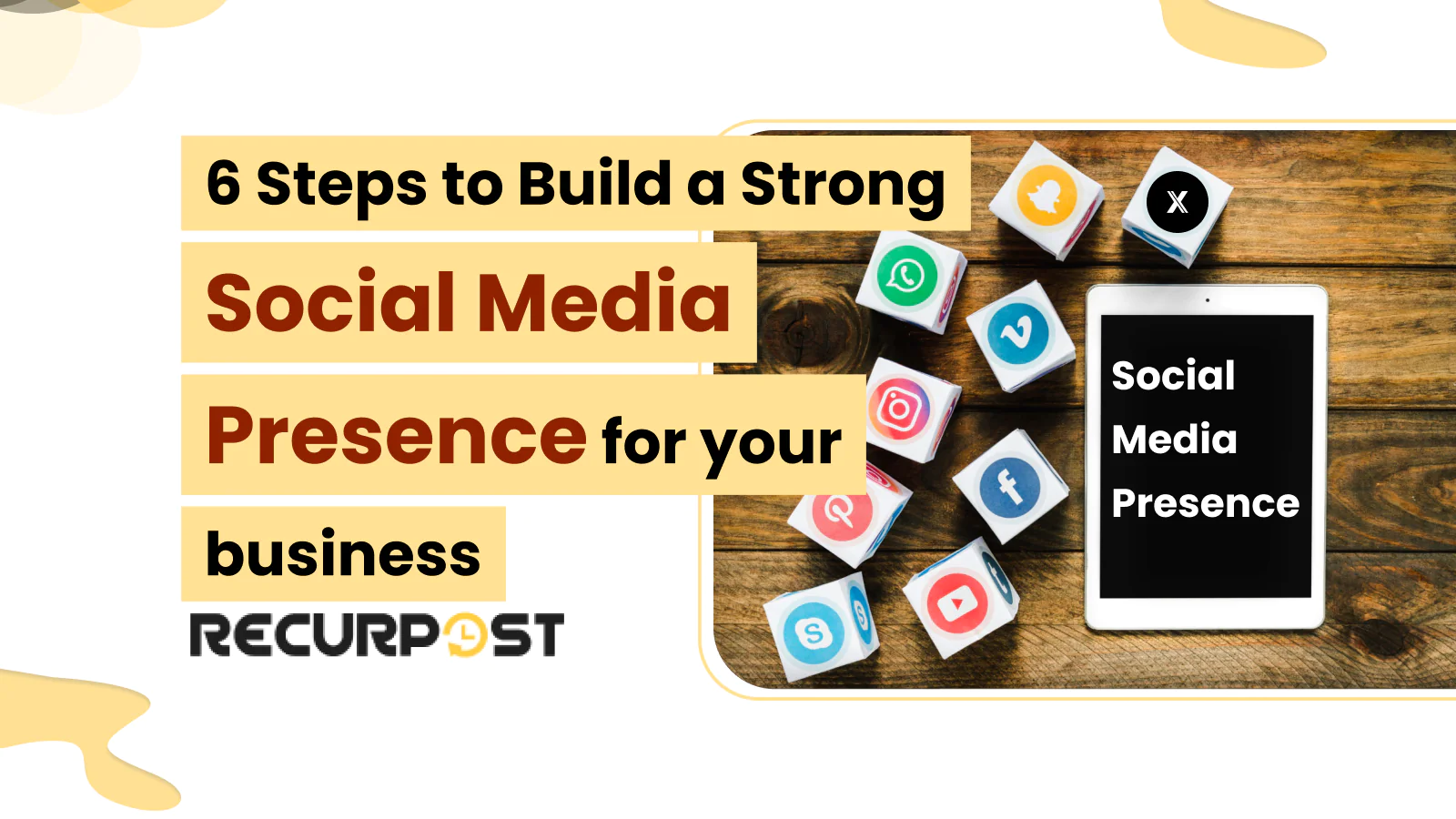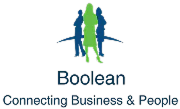Building a strong social media presence for your business requires clear direction. Many small business owners post consistently yet remain invisible online, gaining no traction, attracting no new customers, and relying on guesswork. Social media presents challenges with numerous platforms and trends, causing many to wonder,
“Am I even doing this right?”
Here’s a stat that might surprise you:
78% of consumers say they’re more likely to buy from a brand they follow on social media. So yes, being present online does matter. But just being there isn’t enough. RecurPost has worked with over 100,000 small businesses, identifying effective methods for standing out online and converting followers into loyal customers.
This guide presents six practical, proven steps that help you:
- Show up with confidence
- Attract the right audience
- Build a real presence that drives business results
These steps provide actionable advice applicable immediately, regardless of busy schedules or small teams. A strong social media presence attracts attention from both the audience and competitors.
What is Social Media Presence?
Social media presence represents your brand’s complete digital footprint across social platforms, which includes your visual identity, voice, and audience interactions that collectively build recognition and trust.
Building a strong social media presence lays the foundation for online business growth; it goes far beyond just maintaining active accounts.
Social media presence isn’t just about having accounts on Facebook, Instagram, or LinkedIn. Actual presence means consistently creating valuable content, engaging meaningfully with your audience, and driving measurable business results.
Social media presence encompasses your brand’s appearance, sound, and the emotions people experience when interacting with your content.
Social media presence functions as your brand’s online personality that communicates your values, builds relationships, and drives customer actions through every post, comment, and interaction.
Your social media presence represents the digital persona of your business that audiences encounter online.
What Does a Successful Social Media Presence Include?
Social media presence is made up of a few key parts that work together to create a cohesive brand experience that attracts customers and builds lasting business relationships:
Your Profile Setup
This includes your bio, profile photo, link in bio, and cover image. It’s the first thing people see; make it clear, complete, and consistent.
Your Social Content
Posts, stories, videos, and captions. These all show your brand’s tone and values. Do you educate? Entertain? Share tips? Celebrate customers?
Your Engagement Habits
Do you reply to comments, answer DMs, or leave helpful feedback? That’s how people know there’s a real human behind the account.
Step 1: Define Your Brand Voice & Visual Identity
Have you ever come across a brand’s page and thought: “Wait… is this the same business I saw yesterday?”
That’s what happens when your brand looks different every time you post or when one post sounds quirky and fun, and the next reads like a legal memo. Consistency enables audience recognition, builds trust, and improves brand recall.
Defining brand voice and visual identity eliminates guesswork and builds genuine audience connections. This distinction separates established brands from ordinary social media accounts.
What is Brand Voice?
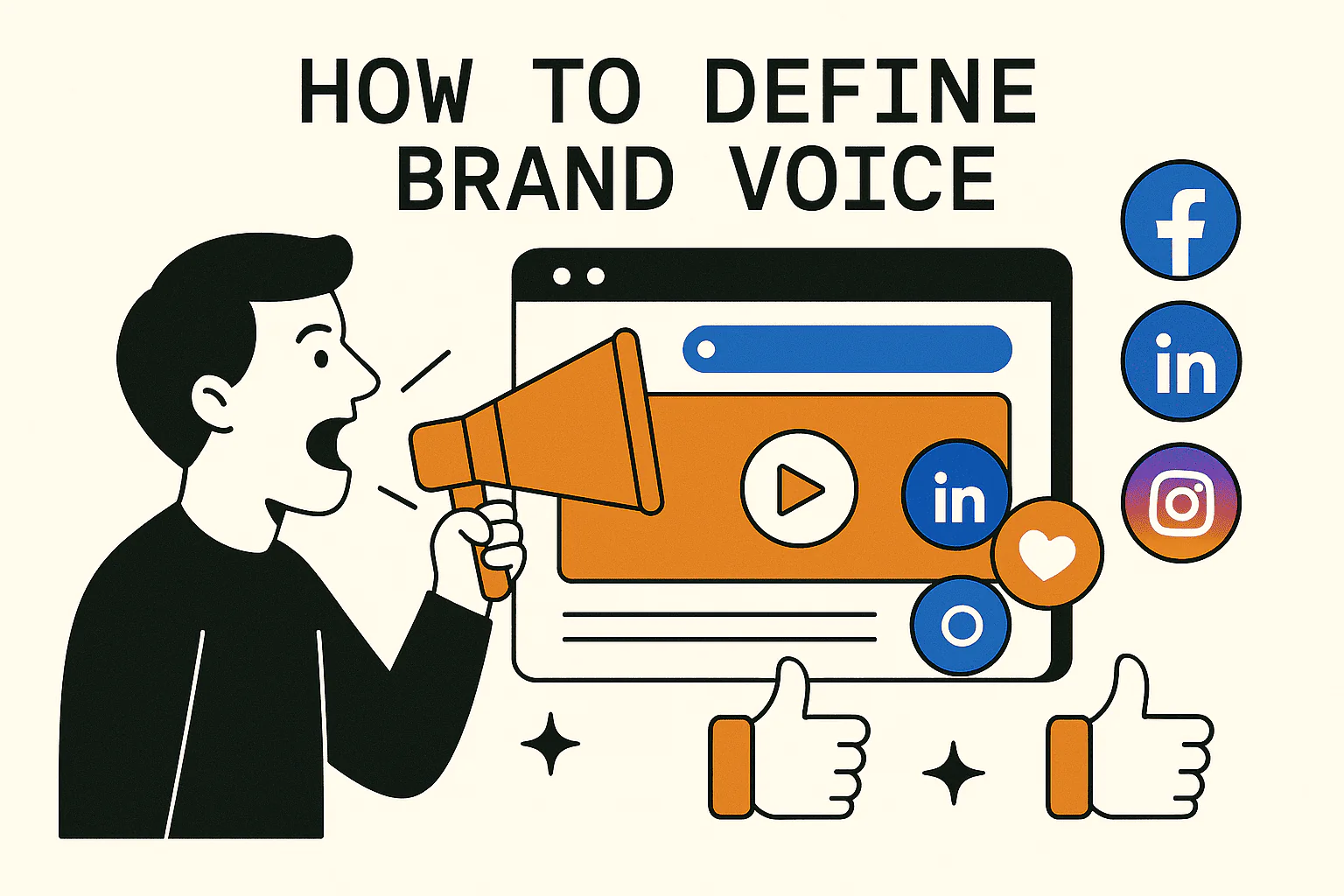
Brand voice combines tone, style, and personality elements your business employs to connect with your audience. Brand voice personifies how your business communicates with its audience.
Brand voice answers questions about:
- Should your tone be casual or formal?
- Do you want to use emojis and humor, or keep it professional and serious?
- Does your brand sound more like a friendly guide or a bold expert?
Applying your defined voice consistently across captions, DMs, stories, replies, and visuals builds audience familiarity and trust.
To Define Your Voice, Ask:
- How do my customers speak?
- What vibe do I want to give, friendly, bold, quirky, smart?
- What tone fits my product or service?
Quick Tip: Pick 3 words to describe your voice (e.g., “relatable, confident, minimal”) and use that as your content filter.
Understand brand voice through the example of Nike:
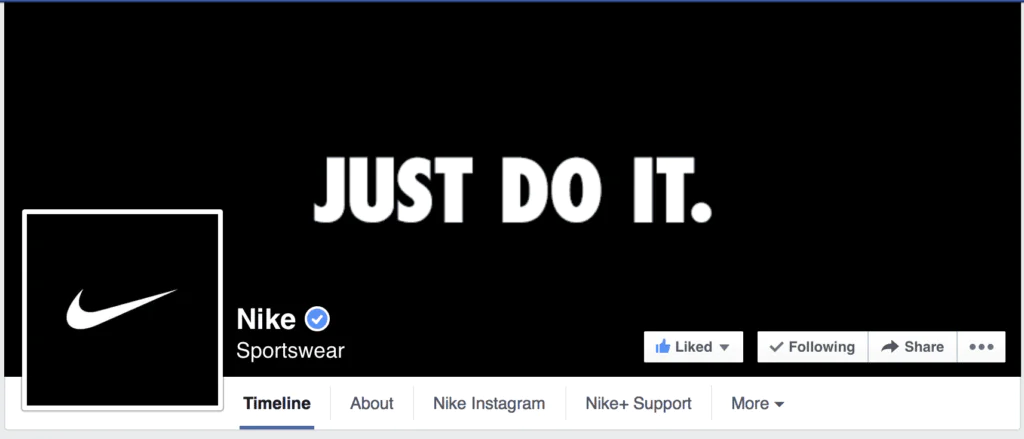
Nike targets athletes and active individuals, so its brand voice is bold, motivational, and action-oriented. This voice is perfectly captured in powerful slogans like “Just Do It” and “You Can’t Stop Us”.
This slogan inspires confidence, determination, and relentless movement. Every message reflects their core identity, pushing limits and empowering people to strive for greatness.
What is Visual Identity?
Visual identity defines your brand’s appearance across social media platforms and significantly impacts audience perception.
Users notice a post’s appearance before reading the content in fast-scrolling environments. Clean, consistent, recognizable branding captures attention, while random or disconnected visuals prompt users to scroll past.
Visual Identity’s Importance on Social Media
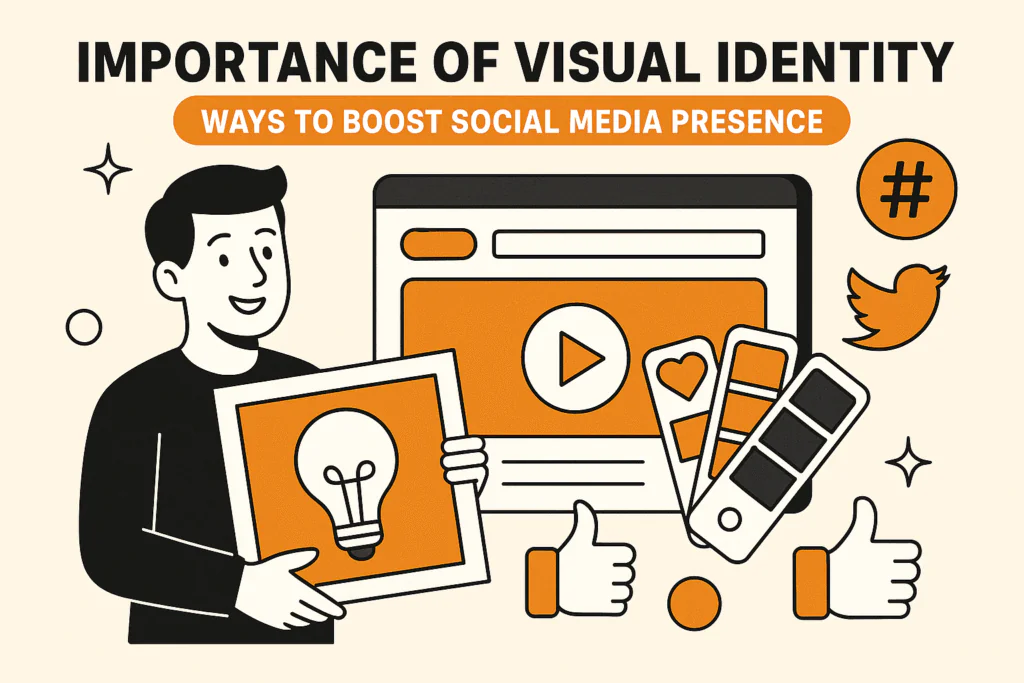
- It builds recognition → People begin to spot your content in-feed, even without your name.
- It adds professionalism → A clean, consistent feed builds trust.
- It makes content creation faster → No guesswork. You know how every post should look.
- It reflects your brand personality visually → without saying a word.
Core Parts of a Visual Identity
Color Palette
Choose 2 to 4 colors that represent your brand’s personality. Use these across your posts, Stories, Highlights, and ads.
- Soft, neutral tones → calm, minimal, lifestyle brands.
- Bright, bold colors → high-energy, youthful, fitness or streetwear.
- Dark, monochrome shades → premium, luxury, tech, or corporate brands.
Fonts
Choose a heading font and a body font that reflect your brand vibe.
- A fun DTC brand might use playful sans-serif fonts.
- A finance coach might prefer a clean serif for authority.
Logo and Icon Style
- Decide where your logo appears (bottom corner? centered?) and keep it consistent across posts.
- Use the same version of your logo everywhere; don’t keep switching between colored and white versions randomly.
Photography Style
Are your photos bright and real, or moody and styled?
- A café might use natural lighting and lifestyle shots.
- A tech brand may lean into polished, minimal product images.
Post Layout and Templates
- Use consistent templates for quotes, announcements, testimonials, etc.
- Create a “grid style” for platforms like Instagram, rows of alternating content, branded text overlays, etc.
- Use Canva’s free Brand Kit to lock in your logo, fonts, and colors so you can apply them in one click.
Understand visual identity through the example of Nike:

Nike’s visual identity is clean, powerful, and instantly recognizable, perfectly aligned with its bold brand voice. The iconic Swoosh logo, minimalistic black-and-white color scheme, and striking imagery of athletes in motion all work together to evoke strength, speed, and determination.
Their visuals often feature high-contrast photography, bold typography, and dynamic compositions that emphasize energy and movement. Whether it’s a billboard, Instagram post, or packaging design, every visual element reinforces Nike’s message of pushing boundaries and performing at your peak.
Quick-Start Table: Build Your Brand Identity
Task | Why It Matters | Tool | Time Needed |
Define brand color palette | Sets tone and builds visual consistency | 10 mins | |
Choose 2 brand fonts | Adds clarity and recognition to posts | 5 mins | |
Create branded templates | Speeds up content creation and enforces brand look | 30 mins | |
Build a brand kit | Keeps brand assets in one place | Canva / Google Drive | 10 mins |
Review the Instagram feed layout | Spot inconsistencies in tone and flow | Phone / Screenshot | 5 mins |
Common Mistakes to Avoid
- Using different filters or colours in every post.
- Relying on random Canva templates with no structure.
- Posting stock photos that don’t match your brand’s tone.
- Copying competitors instead of crafting your visual style.
- Ignoring the layout flow, especially on Instagram.
You’re now ready to show up consistently, and that’s how trust begins.
Next, we’ll talk about Step 2: Picking the Right Platforms so you don’t waste time trying to be everywhere.
Step 2: Pick the Right Social Media Platforms
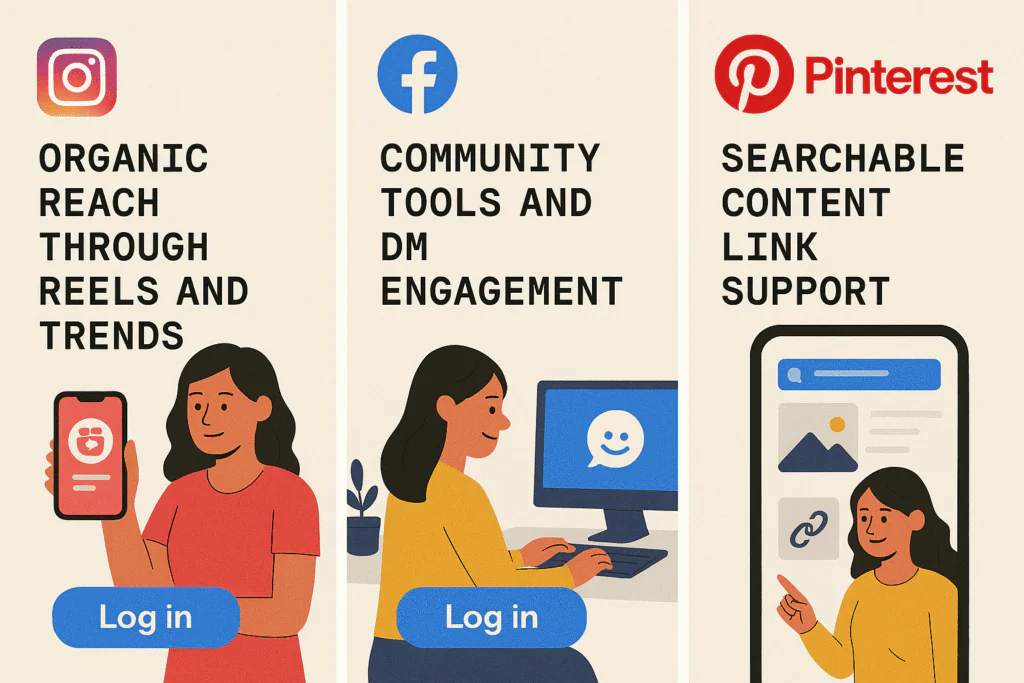
Platform Focus Outperforms Broad social media Presence. Appearing on every platform without a proper strategy results in a mediocre presence across all channels rather than relevance.
Social media success requires impact rather than visibility alone. Focusing on platforms where your audience engages most delivers superior results compared to maintaining a widespread presence.
Updated Platform Demographics & Trends (2025 Snapshot)
Platform | Primary Audience | Trending Content | Notes |
18–34 | Reels, carousels, UGC | Still strong for lifestyle, fashion, wellness, and creators | |
25–55 | Groups, events, and community posts | Best for local services, parenting, and home improvement | |
30–50 | Thought leadership, industry tips | Top for B2B, personal branding, lead gen | |
TikTok | 16–30 | Short videos, challenges | Fast-growing for e-commerce and entertainment |
25–44 (70% female) | Pins, how-to guides | Excellent for DIY, beauty, recipes, fashion | |
YouTube | 18–49 | Long-form, educational, vlogs | Searchable and long shelf life for video content |
X (Twitter) | 25–45 | Real-time opinions, updates | Tech, startups, breaking news |
Decision Matrix: Platform Fit by Business Type
Not every platform works for every business. Here’s a quick overview to match your brand with the channel that makes the most sense.
Business Type | Best Platforms | Why It Works |
Local Bakery | Instagram, Facebook | Visual content + community engagement |
Online Coach | Instagram, LinkedIn, YouTube | Personal branding + long-form content |
SaaS Startup | LinkedIn, Twitter, YouTube | B2B thought leadership + product explainers |
Fashion Brand | Instagram, TikTok, Pinterest | Style-driven content + trend discovery |
Home Decor Brand | Pinterest, Instagram, YouTube | Visual how-tos + product inspiration |
Fitness Trainer | Instagram, TikTok | Lifestyle reels + daily inspiration |
Real-World Examples
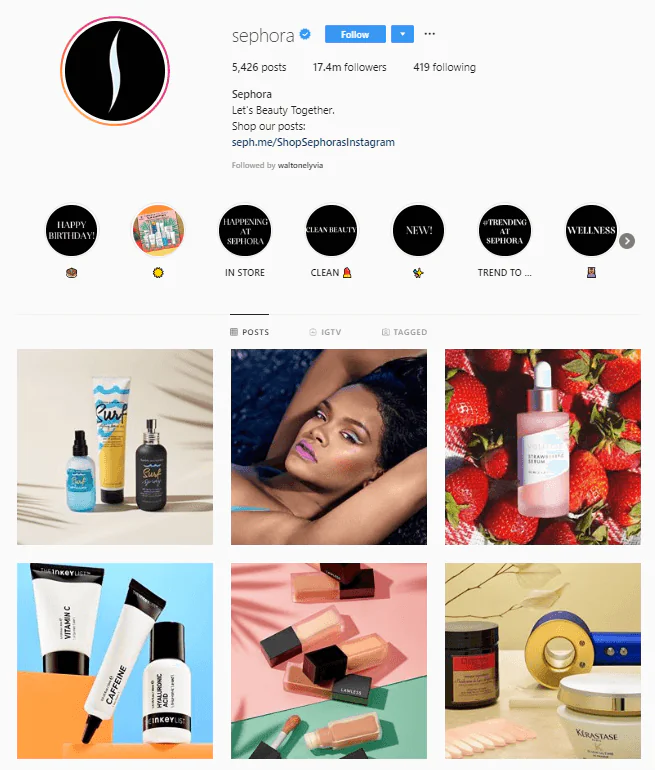
Sephora leans heavily on Instagram and TikTok to reach beauty shoppers, especially Gen Z and Millennials. Their platform choices support visually rich product showcases, influencer partnerships, and UGC (user-generated content), all crucial in the beauty space.
Match Your Goals to the Right Platform
Goal | Platform Match | Rationale |
Build brand awareness | Instagram, TikTok | Great organic reach through Reels and trends |
Drive traffic to website/blog | Pinterest, LinkedIn | Searchable content, link support |
Generate leads | LinkedIn, Facebook | Lead forms + targeting tools |
Sell products | Instagram, Pinterest, TikTok | Integrated shops and creator features |
Build a community | Facebook Groups, Discord, Instagram Close Friends | Community tools and DM engagement |
Emerging Platforms to Watch
- Lemon8 – Gaining traction among Gen Z and lifestyle creators
- Threads – Growing for quick updates, less toxic than Twitter
- YouTube Shorts – Competing directly with TikTok for short-form video
Keep an eye on these, but don’t jump in until you have the bandwidth and content format to support them.
Common Mistakes to Avoid
- Jumping on every platform just because it’s trending.
- Reposting the duplicate content on all platforms.
- Ignoring where your actual audience spends time.
- Not adapting content formats (text on LinkedIn ≠ Reels on Instagram).
- Tracking vanity metrics over business outcomes.
Step 3: Build a Content Plan
Content plans prevent random posting or inactivity by providing structured guidance.
Content plans determine:
- What are you going to post?
- When are you going to post it?
- Why are you posting it?
This structured approach saves time, reduces stress, and delivers clear, consistent brand messaging to your audience.
1. Choose 3 to 5 Content Themes (also called Content Pillars)
Content themes establish main topics for regular discussion, communicating brand focus to your audience.
Example (for a wellness coach):
- Simple workout tips.
- Healthy recipe ideas.
- Stories from real clients.
- Behind the scenes of your daily life.
- Special offers or promotions.
Choose themes that match your brand and what your followers care about.about.
2. Mix Up Your Content Types
Audiences follow brands for content variety rather than repetition or randomness.
Here’s a simple mix to follow:
Type of Post | What It Does | How Often to Post |
Educational | Teaches your audience something useful | About 40% |
Entertaining | Makes them smile or relate | About 30% |
Promotional | Sells your product/service | About 20% |
Community-based | Involves your audience (shout-outs, UGC) | About 10% |
This helps you build trust before you sell.
3. How Often Should You Post?
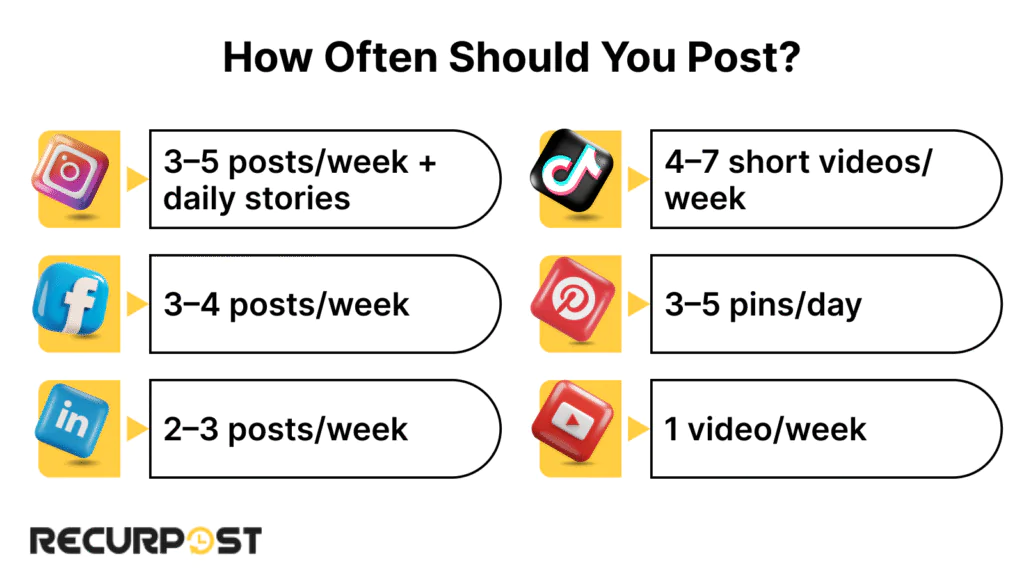
Sustainable posting frequency maintains consistency, which outweighs content volume.
Use the RecurPost Social Media Bulk Scheduler to plan, post consistently, and save hours each week.
4. Plan Your Week with a Simple Content Calendar
A content calendar shows what you’ll post each day. It keeps your content organised and helps avoid last-minute stress.
Understand it with an Example (for Instagram):
- Monday: Motivational quote
- Tuesday: Quick tip or how-to carousel
- Wednesday: Real customer story
- Thursday: Behind-the-scenes video.
- Friday: Product highlight or special offer
This is how you can create the timetable for what to post for all platforms. This will save you a lot of time. You can use tools like Google Sheets, Notion, or RecurPost to plan and schedule everything.
Real Example: Duolingo on TikTok
Duolingo became viral on TikTok by posting funny, relatable videos starring their owl mascot.
They don’t just sell language lessons, they:
- Follow trends
- Use humour to connect with Gen Z
- Post regularly with a clear, fun tone
The result? Massive brand love and high engagement, with zero hard selling.
Tools to Make Planning Easier
- RecurPost – Posting schedule, reuse high-performing ones, and plan your calendar in advance
- Canva – Design branded posts, templates, and stories
- Google Calendar/Notion – Organise and visualise your content week or month at a glance
- Pexels/Unsplash – Free images you can use legally
Avoid These Mistakes
- Posting only when you feel like it
- Being too salesy too often
- Ignoring your analytics
- Posting too much or too little without consistency
- Forgetting to plan for special events or seasonal campaigns
Step 4: Engage Meaningfully With Your Audience
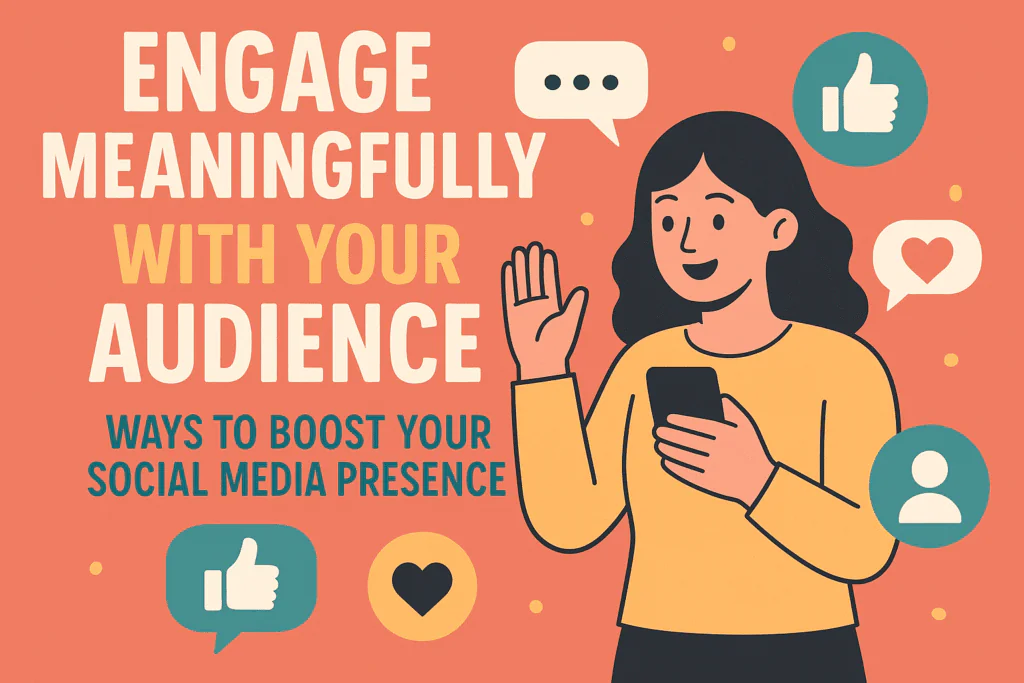
Why Engagement Builds Trust
Social media operates as a two-way conversation rather than one-way broadcasting. Posting without responding or interacting misses the fundamental platform purpose.
Audience engagement makes followers feel heard, valued, and connected to your brand, building trust that generates loyalty and increases sales.
Why It Matters (with Stats)
- 76% of consumers say they’re more likely to buy from a brand they feel connected to.
- 71% of users who have a positive experience with a brand on social media are likely to recommend it to others.
- 42% of customers expect a response on social media within 60 minutes.
Quick, meaningful replies demonstrate care for your audience.
Average Response Time Expectations by Platform
These benchmarks reflect how quickly users expect brands to reply to customer service inquiries, direct messages, and public comments on social media:
Platform | Expected Response Time |
Within 24 hours | |
Same business day | |
Twitter (X) | Within 2 hours |
Within 24–48 hours | |
TikTok | Within 24 hours |
YouTube | Within 1–2 days |
Responding quickly, with a helpful and human voice, builds loyalty and improves customer satisfaction.
Social listening means tracking and analysing what people are saying about your brand, competitors, and industry, even if they don’t tag you directly.
It gives you valuable insights to:
- Discover what your audience truly cares about
- Track brand reputation and feedback
- Spot industry trends early
- Improve content and customer support
According to Meltwater’s 2024 State of Social Report, brands that actively engage in social listening are more likely to understand their audience’s needs and create high-performing content that resonates.
Tools to help:
- RecurPost Inbox: Monitor mentions, DMs, and comments in one place
- Google Alerts: Track mentions of your brand or topics across the web
- Brand24: In-depth monitoring and sentiment analysis
- Hootsuite Streams: Set up keyword-based columns to track brand and industry mentions
- Sprout Social Listening Tools: Understand trending topics and customer pain points
- Excel or Google Sheets: Use for manual tracking if you’re starting out
Convert what you hear into improved content, service, and strategy.
UGC (User-Generated Content): Real People, Real Impact
User-generated content builds authenticity and trust. It shows that real people like your brand, and that speaks louder than any ad.
Brands doing it well:
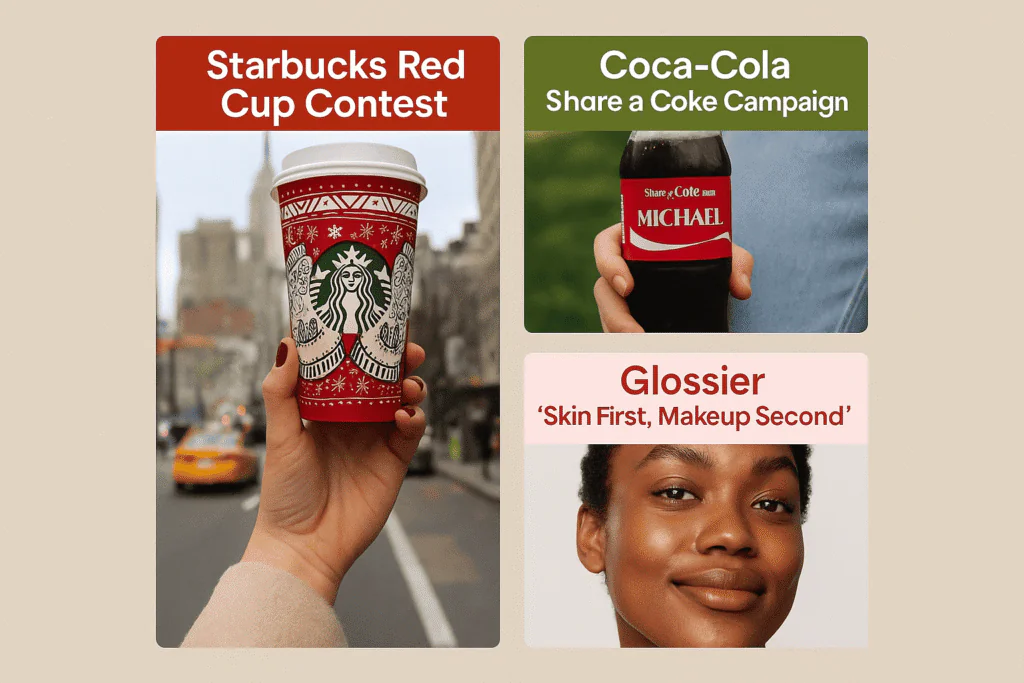
- Starbucks: Runs the annual #RedCupContest campaign each holiday season, inviting customers to share creative photos of their red cups. In 2022, it generated more than 40,000 tagged posts on Instagram.
- Coca-Cola: Their #ShareACoke campaign, launched in over 80 countries, encouraged people to find bottles with their names and post about them. The campaign increased UGC by 870% in the first year. Campaign overview by MarketingWeek.
- Glossier: Their “skin first, makeup second” approach features real customers on their feed, often reposting unfiltered selfies and product reviews. This drove both engagement and product trust.
How you can do it:
- Ask customers to tag you in photos or use a custom hashtag.
- Feature their content on your stories or main feed (with credit)
Tips for Humanizing Your Brand
- Respond to every comment, especially the thoughtful ones.
- Use first names when replying to DMs or comments (when possible).
- Share behind-the-scenes moments to show the people behind the product.
- Use casual, clear language instead of scripted replies.
- Celebrate your followers, thank them, shout them out, and repost them.
Mistakes to Avoid
- Ignoring DMs and comments, especially negative feedback.
- Responding with generic copy-paste replies.
- Turning off comments on posts unless necessary.
- Posting content that doesn’t invite interaction.
Your goal is to build a relationship, not just a follower count.
Step 5: Use Tools to Manage & Scale
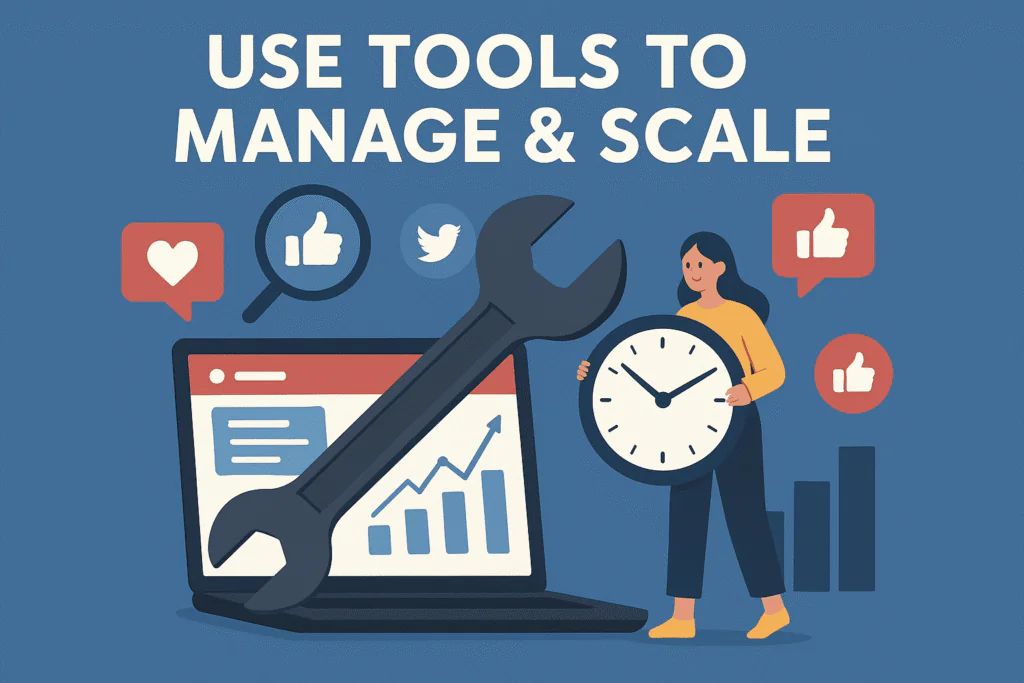
Why Small Businesses Need the Right Tool Stack
Manual social media management works initially, but a growing presence demands full-time attention. Tools enable small businesses to organise efforts, save time, and compete with larger brands without expanding staff.
Proper tools allow businesses to:
- Plan and schedule content in advance.
- Track what’s working (and what isn’t).
- Reply to customers from one dashboard.
- Understand what your audience wants.
Practical tools reduce guesswork and accelerate growth.
Balance Automation with Human Touch
Post automation saves time while human interaction creates authentic connections.
Automate these:
- Scheduling and publishing content.
- Recycling evergreen posts.
- Collecting performance data.
Keep personal:
- Responding to DMs and comments.
- Engaging with followers in Stories or Lives.
- Sharing time-sensitive trends or celebrations.
This balance keeps your presence authentic while helping you scale sustainably.
RecurPost for Smarter Scheduling
Posting consistently is key to building trust, but doing it daily by hand wastes time. RecurPost makes it easy by:
- Letting you schedule posts across platforms.
- Automatically recycling your best content.
- Suggesting optimal posting times for each channel.
- Keeping your social feeds active while you focus on running your business.
What Metrics Should You Track? (Analytics 101)
Don’t just post, measure too. Here are key performance indicators (KPIs) that tell you what’s working:
Metric | What It Tells You |
Engagement rate | How well your audience is interacting |
Share of voice | How often is your brand mentioned vs. others |
Click-through rate (CTR) | How many people click your links |
Conversions | How many actions (sales, signups) result from posts |
RecurPost and tools like Google Analytics can show you all of this in one dashboard.
Recommended Tech Stack for Small Teams
Below is a curated list of top tools categorized by purpose, so you can choose the best fit based on your team size, goals, and workflow:
Category | Tool Options | Primary Use Case |
Content Scheduling | RecurPost, Buffer, Later, Planoly, Hootsuite | Plan, publish, and recycle posts across platforms |
Visual Design & Graphics | Canva, Adobe Express, VistaCreate, Figma | Create branded graphics, posts, and templates |
Video Creation | CapCut, InShot, Adobe Premiere Rush, Animoto | Produce short videos, tutorials, or product reels |
Analytics & Performance | RecurPost Analytics, Google Analytics, Sprout Social, Meta Business Suite | Track engagement, reach, conversions, and audience behavior |
Hashtag Research | Hashtagify, RiteTag, Flick | Find relevant hashtags and measure their performance |
Social Listening & Monitoring | Brand24, Meltwater, Hootsuite Streams, Sprout Listening, Mention | Monitor brand mentions, keywords, and sentiment |
Content Planning & Calendars | Notion, Trello, Airtable, Google Calendar | Organize content strategy and weekly/monthly planning |
AI Content Assistance | ChatGPT, Jasper, Copy.ai | Generate ideas, captions, and draft content faster |
DM & Comment Management | RecurPost Inbox, Sprout Social, AgoraPulse, Zoho Social | Centralized reply to DMs, mentions, and comments |
Link Tracking & Shortening | Bitly, Rebrandly, UTM Builder Tools | Shorten links, track clicks, and set up UTM parameters |
Influencer Collaboration | Upfluence, AspireIQ, Creator.co | Discover, connect, and manage partnerships with influencers |
Step 6: Measure, Learn, and Improve
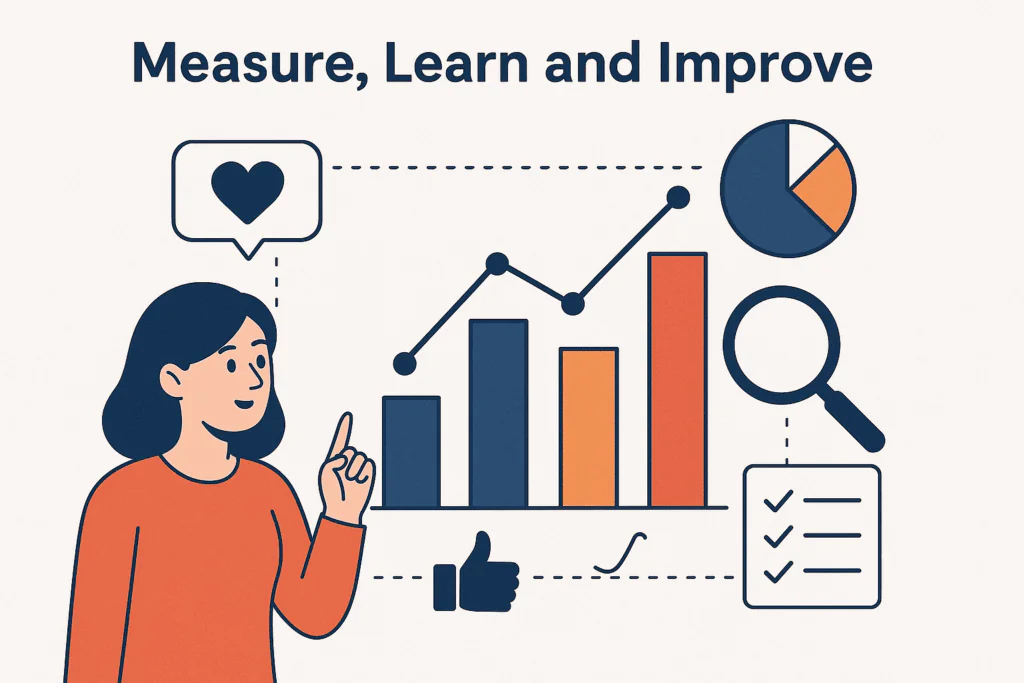
Why Tracking Matters
A strong social media presence is built through consistent measurement, thoughtful time investment, and data-driven decision-making.
Performance tracking enables businesses to:
- Avoid wasting time on low-performing content.
- Double down on what drives engagement and conversions.
- Understand your audience better and fine-tune your messaging.
Metrics That Matter Most
Here’s what to keep an eye on (and why it matters):
Metric | What It Tells You |
Engagement Rate | Are people interacting with your content (likes, comments, shares)? |
Reach & Impressions | How many people are seeing your content and how often? |
Click-Through Rate | Are users clicking on your links or CTAs? |
Follower Growth | Is your audience steadily growing? |
Conversions | Are your posts driving real business actions (sales, signups, downloads)? |
Share of Voice | How often is your brand mentioned compared to competitors? |
Use tools like RecurPost, Google Analytics, and platform-specific insights (Meta, LinkedIn, YouTube) to gather and compare this data.
Monthly Audit Checklist
At the end of each month, review:
- Top-performing posts (by engagement and reach).
- Worst-performing posts (and why they didn’t work).
- Best days and times for posting.
- Audience growth trends.
- Referral traffic to your website from social media.
- Conversion rates by post or campaign.
This data refines content strategy and improves future content creation.
Turn Insights Into Action
Data collection informs these actions:
- Post more of what works (topics, formats, captions).
- Experiment with underused formats (like Stories or Reels).
- Retire content types that consistently underperform.
- Align your content calendar with your audience’s behaviour.
Analytics tracking drives strategic decisions rather than merely accumulating metrics.
Common Mistakes to Avoid
- Ignoring analytics altogether.
- Focusing only on vanity metrics (likes, followers) without looking at engagement or conversions.
- Not setting clear goals before measuring.
- Using too many disconnected tools with no central dashboard..
Tips From Top Brands
Here’s a look at how both small and big brands are creating winning social media strategies and what you can learn from them.
Small Brand: Beardbrand
- Platform Focus: YouTube and Instagram
- What They Do: Share grooming tips, customer stories, and founder insights.
- Takeaway for Small Businesses: Educate your niche and show up authentically; people follow brands that teach and connect.
Big Brand: Wendy’s
- Platform Focus: Twitter (X)
- What They Do: Witty, real-time interactions with customers and competitors. They’ve turned sass into a signature voice.
- Takeaway: A strong, consistent voice can help even a fast-food chain stand out in a noisy space.
Big Brand: Airbnb
- Platform Focus: Instagram and YouTube
- What They Do: Post stories from hosts and travellers around the world.
- Takeaway: UGC and storytelling build trust and emotional connection; use your community’s voice.
Extra Tools & Resources Worth Exploring
- AnswerThePublic – Find trending questions your audience is asking.
- BuzzSumo – Discover high-performing content in your industry.
- SparkToro – Identify where your audience hangs out online.
- Social Media Examiner – Latest tips, updates, and tutorials.
Now you’re equipped not just with a plan, but with proof that it works.
Final Thoughts
These 6 steps build a strong, consistent, meaningful social media presence for solopreneurs, startups, and growing brands by focusing on:
- Start small, stay consistent.
- Focus on real engagement, not just numbers.
- Let data guide your decisions, not assumptions.
Social media success depends on clear, intentional actions rather than attempting everything.
Conclusion: What We’ve Learned and Why It Matters
Strong social media presence begins with clarity about brand appearance, sound, and voice. Defined voice and visuals create recognisable, trustworthy content that builds familiarity and connection.
Focus requires selecting platforms where your audience spends time rather than maintaining a social media presence everywhere. Concentrating on 1-2 channels builds momentum.
Planning prevents random posting through intentional, consistent content calendars that reduce stress while creating clear messages and stronger results.
Engagement builds trust when brands reply to comments, share user content, and demonstrate humanity, converting casual followers into loyal fans.
Scheduling, automation, and analysis tools enable intelligent scaling while saving time and preventing burnout. Tracking provides data about effective and ineffective strategies, guiding future decisions and preventing wasted effort.
Strong social media presence demands brand understanding, audience focus, and purposeful action beyond guesswork or imitation, with each follower, post, and reply shaping brand reputation.
With this roadmap in hand, your next step is implementation. RecurPost can simplify each step as you begin.
Frequently Asked Questions
1. How can I take stock of my current social media presence?
First, do a social media audit. List every active (and inactive) profile in a spreadsheet, noting follower counts, posting frequency, engagement rates, and recent content. Tools like Sprout Social, HubSpot, or Hootsuite offer templates and analytics to make it easy. This helps you spot what’s working, where you’re slipping, and which channels to focus on next.
2. Which social media platforms should my business focus on?
Choose 1–2 platforms where your target audience spends time.
For example:
–Instagram/TikTok for lifestyle or consumer-facing brands
-LinkedIn, if you’re B2B
-Facebook for local services and community engagement
Less is more; platforms beyond these can spread you too thin.
3. What content themes drive meaningful engagement on social media?
Use a mix of four content types:
–Educational (how-tos, case studies)
-Entertaining (memes, quizzes)
-Promotional (product launches, offers)
-Community-based (user-generated content, testimonials)
Studies suggest this balance builds trust and keeps engagement high.
4. How often should I post on Instagram, Facebook, LinkedIn, TikTok, or YouTube?
5. How do I define my brand voice and visual identity for social media?
Brand voice is how your brand speaks, casual, formal, witty, or authoritative. Choose 3 descriptive words (e.g., “friendly, confident, minimalist”) and apply them across posts.
Visual identity includes colors, fonts, logo placement, photography style, and consistent post layouts. A cohesive look makes your brand instantly recognizable.

Fenil Patel makes complex topics simple and useful for readers who want clarity, value, and actionable takeaways. As an SEO content writer with 4+ years of experience, he creates blogs and website content that answer real questions, solve problems, and guide readers toward informed decisions. Whether it’s healthcare, fashion, or SaaS, Fenil’s writing is designed to give you practical insights while ensuring the information you read is trustworthy, engaging, and easy to apply.
